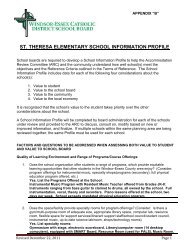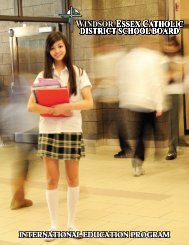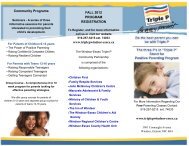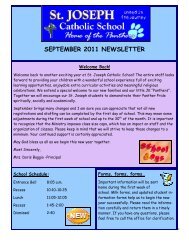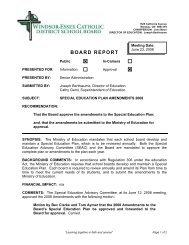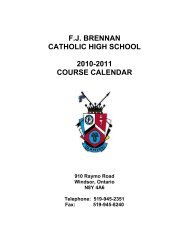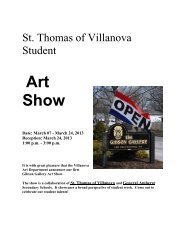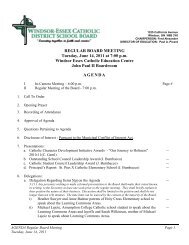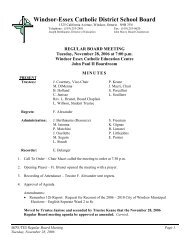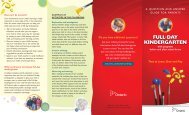Secondary School Student Planning Guide - Windsor-Essex ...
Secondary School Student Planning Guide - Windsor-Essex ...
Secondary School Student Planning Guide - Windsor-Essex ...
Create successful ePaper yourself
Turn your PDF publications into a flip-book with our unique Google optimized e-Paper software.
St. Thomas of<br />
Villanova Catholic<br />
<strong>Secondary</strong> <strong>School</strong><br />
Holy Cross<br />
Sacred Heart<br />
St. Anthony<br />
St. Bernard (Amherstburg)<br />
St. Joseph<br />
St. Mary<br />
Stella Maris<br />
F. J. Brennan<br />
Catholic High <strong>School</strong><br />
Our Lady of Lourdes<br />
St. Bernard (<strong>Windsor</strong>)<br />
St. John Vianney<br />
St. Jules<br />
St. Maria Goretti<br />
St. Rose<br />
W.J. Langlois<br />
St. Joseph’s<br />
Catholic High <strong>School</strong><br />
L.A. Desmarais<br />
H.J. Lassaline<br />
St. Anne French Immersion<br />
St. Michael's Alternate Programs<br />
St. Michael's Alternate Programs:<br />
Assumption College<br />
Catholic High <strong>School</strong><br />
St. James<br />
St. John<br />
St. Anne<br />
Catholic High <strong>School</strong><br />
St. Gregory<br />
St. John the Baptist<br />
St. John the Evangelist<br />
St. Peter<br />
St. Pius X<br />
St. William<br />
1) support students to set education goals and remain in school, and/or<br />
2) provide alternative delivery models to support student learning, and/or<br />
3) service adults who wish to complete a high school diploma<br />
Holy Names<br />
Catholic High <strong>School</strong><br />
Christ the King<br />
Notre Dame<br />
Our Lady of<br />
Mount Carmel<br />
St. Christopher<br />
St. Gabriel<br />
St. Michael's Alternate High <strong>School</strong><br />
Tuscarora Campus<br />
Adult Campus<br />
Alternative Education Opportunities<br />
Cardinal<br />
Carter Catholic<br />
<strong>Secondary</strong> <strong>School</strong><br />
Holy Name<br />
Our Lady of the<br />
Annunciation<br />
Queen of Peace<br />
St. John de Brebeuf<br />
St. Louis<br />
Catholic Central<br />
High <strong>School</strong><br />
Immaculate Conception<br />
Our Lady of<br />
Perpetual Help<br />
St. Angela<br />
St. Bernard (<strong>Windsor</strong>)<br />
Alternative Ways of Earning Credits Towards the Ontario <strong>Secondary</strong> <strong>School</strong> Diploma<br />
The majority of secondary school students will earn their credits towards the Ontario <strong>Secondary</strong> <strong>School</strong> Diploma by enrolling in the<br />
courses offered at their secondary school. However, a number will wish to consider alternative ways of earning the required credits. The<br />
options available to such students include: dual credit courses offered by St.Clair College, correspondence courses offered by the<br />
Independent Learning Centre (www.ilc.org); independent study; continuing education (including summer school), Continuous Intake<br />
Co-op and e-learning.<br />
Supervised Alternative Learning Program (SAL) may be useful for young people between the ages of 14-17 who are not attending<br />
school regularly and are at risk of not graduating, yet want to continue their learning after all alternative education opportunities have<br />
been attempted or other retention strategies have not been successful. For more information regarding the SAL program, contact your<br />
school principal or guidance counsellor.<br />
Dual Credit Opportunities<br />
Earn Two Credits For One Course With Dual Credit Offerings At St. Clair College<br />
Dual credit programs allow senior high school students the opportunity to earn high school and college credits at the same time.<br />
<strong>Student</strong>s attend one of St. Clair College’s campuses for either a full or half day once a week for a fifteen week period. This unique<br />
arrangement allows you, the student, the chance to experience life and learning in a college environment and allows you to fast track<br />
towards your post secondary goals.<br />
Dual credit programs are intended to assist secondary school students in the completion of their OSSD and provide a successful<br />
transition to college and apprenticeship programs. As well, students in Specialist High Skills Major (SHSM) programs and the Ontario<br />
Youth Apprenticeship Programs (OYAP) are eligible to enroll. Enrolment in half or full day Co-op allows greater flexibility to<br />
participate.<br />
Examples of dual credit offerings include: Conflict Management, Photojournalism, Home Renovation Trade Skills, Electrical Installation,<br />
Introduction to Early Childhood Education, Baking & Pastry Arts, Basic Welding Process and Fabricating, Health and Wellness<br />
Fundamentals, Common Core Shop Practices, Administrative Procedures and Environmental Design.<br />
A maximum of 4 college-delivered dual credits can be counted as optional credits towards the Ontario <strong>Secondary</strong> <strong>School</strong> Diploma<br />
(OSSD). Dual Credits cannot be used as substitutions for compulsory credit requirements.<br />
To participate, you MUST be referred to the program through your <strong>School</strong> <strong>Student</strong> Success Team. St. Clair College will not accept<br />
applications directly. For a list of dual credit course offerings, visit www.wecdsb.on.ca<br />
“Therefore, encourage one another and build up one another, as indeed you are doing.“ (1 Thessalonians 5:11)<br />
In co-operation with the students, and with communication between parents and school staff, students are directed to a particular St.<br />
Michael’s campus, based on individual needs. The St. Michael's program serves diploma bound students, school-work transition<br />
students, and continuing education - adult students.<br />
The goal of the Alternate program is to ensure that students experience success in order for them to re-integrate into the traditional<br />
school system and continued education, or gain employability skills that will support the transition from school to work. There are two<br />
locations where students can access alternate education:<br />
• Tuscarora Campus 735 Tuscarora St., <strong>Windsor</strong> T 519.977.6161<br />
• Adult Campus 477 Detroit St., <strong>Windsor</strong> T 519.946.3761<br />
COMPLETE YOUR HIGH SCHOOL DIPLOMA<br />
St. Michael’s Alternate Programs can help you complete your high school diploma even if you are working full-time.<br />
Opportunities exist for Co-op, e-Learning and correspondence courses as well as traditional classroom instruction.<br />
If you are 18 or older, you could also be eligible for some equivalent credits. A program can be designed to<br />
individual needs. Call 519.251.4784 for a consultation appointment or visit paidcoop.wetpaint.com<br />
519.735.8664 519.736.5037 519.322.2636 519.735.8218 519.252.9313<br />
<strong>Student</strong> Trustees<br />
Trustees<br />
F. Favot<br />
B. Mastromttei<br />
Madeline Ellepola<br />
Joseph Najem<br />
519.253.2116<br />
“Do not neglect the gift that is in you.” (1 Timothy 4:14a)<br />
519.966.6989 519.979.8123 519.819.9976<br />
519.974.9776 (Brennan)<br />
519.322.5983 (Carter)<br />
J. McMahon<br />
<strong>Secondary</strong> <strong>School</strong><br />
<strong>Student</strong> <strong>Planning</strong> <strong>Guide</strong><br />
"What does God ask of you but to do justice, and love tenderly, and to walk humbly with your God” Micah 6:8<br />
The student is expected to be:<br />
A Discerning Believer formed in the<br />
Catholic Faith community who celebrates the<br />
signs and sacred mystery of God’s presence through<br />
word, sacrament, prayer, forgiveness, reflection<br />
and moral living.<br />
An Effective Communicator who speaks,<br />
writes, and listens honestly and sensitively, responding<br />
critically in light of gospel values.<br />
A Reflective, Creative and Holistic Thinker who<br />
solves problems and makes responsible decisions with<br />
an informed moral conscience for the common good.<br />
Associate Director of Education:<br />
Cathy Geml<br />
Director of Education:<br />
Paul Picard<br />
A Self-Directed, Responsible, Life Long<br />
Learner who develops and demonstrates their<br />
God-given potential.<br />
A Collaborative Contributor who finds<br />
meaning, dignity and vocation in work which respects<br />
the rights of all and contributes to the common good.<br />
A Caring Family Member who attends to<br />
family, school, parish, and the wider community.<br />
A Responsible Citizen who gives witness to<br />
Catholic social teaching by promoting peace, justice<br />
and the sacredness of human life.<br />
Executive Superintendents:<br />
Jamie Bumbacco • Mario Iatonna<br />
Superintendents:<br />
Emelda Byrne • Patrick Murray • Sharon O'Hagan-Wong<br />
Mike Seguin • JoAnne Shea • John Ulicny<br />
<strong>Windsor</strong>-<strong>Essex</strong> Catholic District <strong>School</strong> Board, 1325 California Avenue, <strong>Windsor</strong>, Ontario N9B 3Y6<br />
Tel: 519.253.2481 • Fax: 519.253.4819 • www.wecdsb.on.ca • Follow us on Twitter @WECDSB<br />
All of our secondary schools follow a semester system with two mark reporting periods per semester. <strong>Student</strong>s carry four courses from<br />
September to January and an additional four from February to June. An essential element of Catholic Education is the formal teaching<br />
of religion. <strong>Student</strong>s must select a Catholic Studies course each academic year.<br />
Steps in the <strong>Planning</strong> Process<br />
• Ensure you have an appropriate e-mail account<br />
• Review diploma and certificate requirements<br />
• Examine course offerings and course descriptions in the school course calendar<br />
• Review “Jump Start Your Life” booklet for information about the four<br />
post secondary pathways: apprenticeship, college, university, and work<br />
• Research entrance requirements for post secondary programs<br />
• Consult teachers and Guidance Counsellors<br />
• Update course selection planning chart (see opposite side) and review your education plan<br />
and / or <strong>Student</strong> Success Credit Tracker<br />
Upon completion of the above, you will select your courses for the following year online through Course Quest<br />
MUST VISIT WEBSITES for <strong>Student</strong>s and Parents:<br />
• www.wecdsb.on.ca: our Board website; navigate through “<strong>Student</strong>s” and “Programs” portals<br />
• <strong>School</strong> Course Calendars<br />
• Specialist High Skills Major Programs<br />
• “Jump Start Your Life” booklet<br />
• 40 Hour Community Involvement Manual<br />
• Apprenticeship Information<br />
• Career Cruising (Note: If accessing this site at home, obtain your school’s username<br />
and password and visit www.careercruising.com)<br />
• www.osca.ca: Ontario <strong>School</strong> Counsellors’ Association<br />
• www.edu.gov.on.ca: Ministry of Education website<br />
• www.oyap.com: Ontario Youth Apprenticeship Program<br />
• www.ontario.ca/shsm<br />
• www.edu.gov.on.ca/studentsuccess<br />
• www.apprenticesearch.com<br />
“Let the wise also hear and gain in learning, and the discerning acquire skills.” (Proverbs 1:5)<br />
Provincial Report Card<br />
A standard report card is used throughout the province of Ontario to report on student achievement. Report cards are issued four times a year,<br />
at midterm and at the end of each semester.<br />
The Ontario <strong>Student</strong> Record (OSR)<br />
The OSR is the official school record for a student. Every Ontario school keeps an OSR for each student enrolled at that school. The OSR<br />
contains achievement results, credits earned and diploma requirements completed and other information important to the education of the<br />
student. These records are protected by the Education Act and the Freedom of Information Legislation. The Ontario <strong>Student</strong> Record (OSR)<br />
<strong>Guide</strong>line (www.edu.gov.on.ca/eng/document/curricul/osr/osr.pdf) sets out all the policies pertaining to the OSR.<br />
The Ontario <strong>Student</strong> Transcript (OST)<br />
The OST is an official and consistent summary of a student’s achievement in Ontario secondary school credit-bearing courses. A current,<br />
accurate and complete copy of the OST is included within the Ontario <strong>Student</strong> Record. The Ontario <strong>Student</strong> Transcript (OST) Manual<br />
(www.edu.gov.on.ca/eng/general/elemsec/ost/ost2010.pdf) provides the information and guidelines required for the establishment,<br />
maintenance, issue, and storage of the Ontario <strong>Student</strong> Transcript. It also outlines the procedures that apply to the recording of information in<br />
various situations.<br />
Code of Conduct<br />
All students, parents, teachers and staff have the right to be safe, and feel safe, in their school community. With this right comes the responsibility<br />
to be law-abiding citizens and to be accountable for actions that put at risk the safety of others or oneself. The Ontario Code of Conduct sets<br />
clear provincial standards of behaviour and specifies mandatory consequences for students’ actions that do not comply with these standards.<br />
The complete <strong>School</strong> Code of Conduct can be found in the <strong>Student</strong> Handbook each student receives at the beginning of the school year. To<br />
access the Board’s Code of Conduct Policy, visit www.wecdsb.on.ca >Board> Policies. For further information about safe schools, visit<br />
www.edu.gov.on.ca/eng/teachers/safeschools.html.<br />
Full Disclosure of Course Outcomes for Grades 11 and 12<br />
All attempted courses in Grade 11 and 12 will be recorded on the Ontario <strong>Student</strong> Transcript.<br />
If a student withdraws from a Grade 11 or 12 course within 5 instructional days following the distribution of the mid-term report card, the course<br />
will not be recorded on the student‘s transcript.<br />
If a student withdraws from a Grade 11 or 12 course after 5 instructional days following the distribution of the mid-term report card, a “W” is<br />
assigned and the student’s mark at the time of withdrawal is recorded.<br />
Assessment, Evaluation and Reporting of <strong>Student</strong> Achievement<br />
Growing Success: Assessment, Evaluation, and Reporting in Ontario <strong>School</strong>s (www.edu.gov.on.ca/eng/policyfunding/growSuccess.pdf)<br />
outlines the policies and practices for the assessment, evaluation, and reporting of the achievement of curriculum expectations and the<br />
development of learning skills and work habits for all students in Grades 1 to 12 in Ontario schools.<br />
<strong>Student</strong> evaluation is based on the expectations found in the Ontario Provincial Curriculum and Policy documents. <strong>School</strong> and Board policies are<br />
based on these provincial documents. To access secondary curriculum policy documents on the ministry website, visit:<br />
www.edu.gov.on.ca/eng/curriculum/secondary/subjects.html<br />
Through the Provincial Report Card, schools report student progress using the following components:<br />
1) The Percentage Grade<br />
For Grades 9 to 12, a final grade (percentage mark) will be determined as follows:<br />
70% of the grade will be based on evaluation conducted through the course.<br />
• <strong>Student</strong>'s most consistent level of achievement throughout the course<br />
• Special consideration should be given to more recent evidence of achievement<br />
30% of the grade will be based on the final evaluation<br />
• administered at or towards the end of the course<br />
• a portion of the 30% final evaluation will be administered on the board scheduled examination day<br />
• based on evidence from one or a combination of an examination, a performance, an essay or another method<br />
of evaluation suitable to the course content<br />
The final grade demonstrates the comprehensive achievement of the overall expectations for the course<br />
2) The Learning Skills<br />
The report card provides a record of learning skills demonstrated by the student in every course, in the following six categories:<br />
Responsibility, Organization, Independent Work, Collaboration, Initiative and Self-Regulation. The learning skills are evaluated using a<br />
four-point scale (E-Excellent, G-Good, S-Satisfactory, N-Needs Improvement). The separate evaluation and reporting of learning skills<br />
reflects their critical role in students' achievement of the curriculum expectations.<br />
3) Report Card Comments<br />
The report card includes teachers’ comments that focus on what students have learned, describe significant strengths and<br />
identifies next steps for improvement.<br />
Course of Study Outlines<br />
Courses of Study Outlines are available at the school and have been developed according to the requirements of the Ontario Ministry of<br />
Education. During the school year, parents and students have the opportunity for direct consultation with teachers regarding courses of study,<br />
assessment and evaluation policies and other points of interest. Course syllabi summarizing the course of study and the assessment and<br />
evaluation plan is given to students at the beginning of the course. To access secondary curriculum policy documents on the Ministry website,<br />
visit: www.edu.gov.on.ca/eng/curriculum/secondary/subjects.html<br />
Prior Learning Assessment and Recognition (PLAR)<br />
The PLAR process involves two components: “challenge” and “equivalency”. The first component will allow students to challenge any Grade 10,<br />
11 and 12 course and earn up to four (4) credits towards the secondary school diploma, with a maximum of two (2) credits from any one<br />
discipline. <strong>Student</strong>s may challenge a course and be granted the credit if they can demonstrate the required skills and knowledge through formal<br />
tests and other assessment strategies. When a student enters our system from outside Ontario, the principal of the school assesses the<br />
student’s academic credentials. Based on these credentials, the principal may grant credits for equivalent courses completed by the student in<br />
the province or country of origin.<br />
In order to initiate the “challenge” or “equivalency” process, students must contact the school administration. <strong>Student</strong>s wishing to challenge a<br />
course must attend the PLAR workshop held annually in the month of March. The registration deadline is March 1.<br />
“May the God of steadfastness and encouragement grant you to live in harmony with one another.” (Romans 15.5)
The Ontario secondary school program is designed to equip all students with the knowledge and skills they need for successful outcomes – smooth<br />
transitions to the post secondary destinations of their choice: apprenticeship, college, community living, university, or the workplace. Our schools offer<br />
an education program in a safe and secure environment that promotes a high standard of achievement and provides all students with the learning opportunities<br />
and support they need. <strong>Secondary</strong> schools of the <strong>Windsor</strong>-<strong>Essex</strong> Catholic District <strong>School</strong> Board provide courses, programs, supports and<br />
experiences that are relevant to students’ interests and needs and to society’s needs and expectations.<br />
Courses in the curriculum have been organized to provide clear educational paths for students to select appropriate courses. The provision of<br />
different types of courses leading to specific destinations allows students to acquire a solid core of theoretical and applied learning and to focus learning<br />
on goals that have relevance for them.<br />
These courses are designed to<br />
provide students with a broad<br />
educational base that will prepare<br />
them for their studies in Grade 11<br />
and 12 and for productive<br />
participation in society.<br />
These courses allow<br />
students to broaden their<br />
knowledge and skills in a<br />
particular subject that may<br />
or may not be directly<br />
related to postsecondary<br />
goals. These courses are<br />
appropriate for all students<br />
regardless of postsecondary<br />
destination.<br />
The first 3<br />
characters refer<br />
to the Subject<br />
and Course<br />
These courses focus on the<br />
knowledge and skills that students<br />
need to be well prepared for<br />
success in Grade 11 Workplace<br />
Preparation courses. These<br />
courses focus on developing and<br />
enhancing strategies needed for<br />
better literacy and numeracy skills.<br />
These courses are<br />
designed to equip students<br />
with the knowledge and<br />
skills for direct entry into the<br />
workplace or for admission<br />
to some apprenticeship<br />
programs. The range and<br />
content of the courses allow<br />
students to prepare for a<br />
variety of jobs, training<br />
programs and careers.<br />
These courses emphasize<br />
workplace applications of<br />
the course content.<br />
The fourth character<br />
refer to the Grade Level<br />
1 = Grade 9<br />
2 = Grade 10<br />
3 = Grade 11<br />
4 = Grade 12<br />
Grade Nine and Ten Courses<br />
College preparation courses<br />
are designed to equip<br />
students with the knowledge<br />
and skills to meet the<br />
entrance requirements for<br />
college programs. These<br />
courses emphasize concrete<br />
applications of the material<br />
covered in the course and<br />
emphasize the development<br />
of critical thinking and<br />
problem solving skills.<br />
Applied courses develop<br />
students’ knowledge and skills by<br />
emphasizing practical, concrete<br />
applications of concepts and<br />
incorporating theoretical applications<br />
as appropriate.<br />
Grade Eleven and Twelve Courses<br />
Course Coding<br />
These courses are<br />
designed to equip students<br />
with the knowledge and<br />
skills to meet the<br />
entrance requirements for<br />
specific university and<br />
college programs. Teaching<br />
and learning emphasize<br />
both theoretical aspects<br />
and related concrete<br />
applications.<br />
The fifth character refers to the of course:<br />
C = College<br />
M = University / College<br />
D = Academic<br />
P = Applied<br />
E = Workplace<br />
O = Open<br />
L = Locally Developed U = University<br />
Academic courses develop<br />
students’ knowledge and skills by<br />
emphasizing theoretical, abstract<br />
applications of the essential<br />
concepts and incorporating practical<br />
applications as appropriate.<br />
These courses equip<br />
students with the knowledge<br />
and skills to meet<br />
the entrance requirements<br />
for university programs.<br />
Teaching and learning<br />
emphasizes theoretical<br />
aspects of the course<br />
content as well as concrete<br />
applications.<br />
The sixth character is<br />
assigned by the board.<br />
Contact the guidance<br />
department for further<br />
information.<br />
<strong>Secondary</strong> <strong>School</strong> Credits<br />
A credit is granted in recognition of the successful completion (that is, completion with a final percentage mark of 50 per cent or higher) of a course that<br />
has been scheduled for a minimum of 110 hours. Credits are granted by a principal on behalf of the Minister of Education for courses that have been<br />
developed or authorized by the ministry. A half-credit may be granted for each 55-hour part of a 110-hour ministry-developed course in accordance with<br />
the policy outlined in the curriculum policy documents. Most courses are offered as single-credit courses. Some courses, such as technological<br />
education, interdisciplinary studies, and cooperative education courses, may be offered as multiple-credit courses.<br />
Specialist High Skills Major (SHSM):<br />
<strong>School</strong>s are providing students with more opportunities to customize their high school experience and build on their strengths and interests<br />
through a variety of new and enhanced learning options. One of those options is the Specialist High Skills Major (SHSM). A SHSM is a<br />
Ministry-approved specialized career-focused program that allows student to acquire knowledge and skills that are of particular importance in<br />
specific economic sectors and earn certifications recognized in those sectors, as they work towards meeting the requirements for an OSSD. A<br />
SHSM enables students to gain sector-specific skills and knowledge in the context of engaging, career-related learning environments and helps<br />
them focus on graduation and on pursuing their postsecondary goals. WECDSB currently offers SHSM programs in 7 high schools as follows:<br />
Agriculture: Cardinal Carter Catholic <strong>Secondary</strong> <strong>School</strong><br />
Arts & Culture: F. J. Brennan Catholic High <strong>School</strong> and St. Joseph's Catholic High <strong>School</strong><br />
Business: Holy Names Catholic High <strong>School</strong><br />
Construction: Cardinal Carter Catholic <strong>Secondary</strong> <strong>School</strong><br />
Energy: St. Anne Catholic High <strong>School</strong><br />
Environment: St. Anne Catholic High <strong>School</strong><br />
Health & Wellness: St. Joseph's Catholic High <strong>School</strong><br />
Hospitality & Tourism: Assumption College Catholic High <strong>School</strong><br />
Information & Communications Technology:St. Anne Catholic High <strong>School</strong> and St. Thomas of Villanova Catholic <strong>Secondary</strong> <strong>School</strong><br />
Sports: F. J. Brennan Catholic High <strong>School</strong><br />
For more information about any of these programs consult individual school course calendars or visit www.wecdsb.on.ca<br />
Specialized Programs:<br />
Specialized programs are programs that provide students with a particular curriculum focus to assist them in meeting diploma requirements and<br />
in making the transition to post secondary destinations (i.e. apprenticeship programs, college, university, and the workplace). Specialized<br />
programs may offer a comprehensive and integrated set of courses, supports and experiences that may be spread over a number of semesters<br />
or years and may result in a specialized diploma. The Board offers specialized programming at specific schools including:<br />
• French Immersion (Cardinal Carter, St. Anne, St. Joseph’s, St. Thomas of Villanova)<br />
• English Language Learners (Cardinal Carter, Catholic Central)<br />
• International Baccalaureate Programme (Assumption College High <strong>School</strong>)<br />
• International Education: WECDSB is connecting students all over the world through our International Education Program.<br />
<strong>Student</strong>s gain first-hand experience of other cultures in a world that is becoming increasingly globalized. Through international<br />
education, students are able to gain an understanding of how others view our world and in turn develop a greater appreciation<br />
of their place in it.<br />
For more information about any of these programs consult individual school course calendars and/or contact the specific school.<br />
Changing Pathways:<br />
<strong>Student</strong>s are not locked into a specific pathway during their high school experience. Various mechanisms facilitate the change from one course<br />
type or program pathway to another should students’ goals or interests change. Consult your Guidance Dept. for more information.<br />
Course Selection Change:<br />
Parents and students should be aware that courses are offered and student timetables are constructed based on initial course selections. Careful<br />
consideration should be given to these selections. Course changes may be made in consultation with guidance counsellors at appropriate times,<br />
provided space is available in the alternative courses.<br />
Policy on Substitution for Compulsory Credits:<br />
Substitutions may be made for a limited number of compulsory credits. To meet individual students’ needs, the principal may replace up to three<br />
compulsory credits. The decision to make a substitution is made in consultation with parents and appropriate school staff. Each substitution will<br />
be noted on the student’s Ontario <strong>Student</strong> Transcript.<br />
Procedures for <strong>Student</strong>s Who Fail or Do Not Complete Courses:<br />
The principal and teaching staff, in collaboration with the student and/or parent(s), will determine the procedure or type of program will best enable<br />
the student to meet the curriculum expectations and earn credit for the course. Repeating the entire course during the school year or upgrading<br />
during Summer <strong>School</strong> are common means to recover a credit. Credit Rescue and Credit Recovery programs may be accessed through your<br />
<strong>School</strong> Success Team. Contact your <strong>Student</strong> Success teacher for more information.<br />
<strong>Student</strong>s may earn an Ontario <strong>Secondary</strong> <strong>School</strong> Diploma, an Ontario <strong>Secondary</strong> <strong>School</strong> Certificate or a Certificate of Accomplishment.<br />
The Ontario <strong>Secondary</strong> <strong>School</strong> Diploma (OSSD)<br />
In order to earn an Ontario <strong>Secondary</strong> <strong>School</strong> Diploma, a student must complete:<br />
Plus<br />
Plus<br />
Plus<br />
<strong>Student</strong>s must earn the following compulsory credits to obtain the Ontario <strong>Secondary</strong> <strong>School</strong> Diploma:<br />
4 credits in English (1 credit per grade)*<br />
3 credits in mathematics (at least 1 credit in Grade 11 or 12)<br />
2 credits in science<br />
1 credit in Canadian history<br />
1 credit in Canadian geography<br />
1<br />
1<br />
1<br />
18 compulsory credits<br />
Plus one credit from each of the following groups:<br />
Community<br />
Involvement Requirement<br />
<strong>Student</strong>s must complete a minimum of 40 hours of<br />
community involvement activities during their years in the<br />
secondary school program. This requirement is completed<br />
outside normal instructional hours in a variety of settings.<br />
<strong>Student</strong>s may not fulfill this requirement through activities<br />
that are counted towards a credit, through paid work, or by<br />
assuming duties normally performed by a paid employee.<br />
For more information, visit www.wecdsb.on.ca and follow<br />
the links under Programs.<br />
1 credit in the arts<br />
1 credit in health and physical education<br />
1 credit in French as a second language<br />
0.5 credit in career studies<br />
0.5 credit in civics<br />
group 1: additional credit in English, or French as a second language**, or a Native language, or a classical<br />
or international language, or social sciences and the humanities, or Canadian and world studies, or guidance<br />
and career education, or cooperative education***<br />
group 2: additional credit in health and physical education, or the arts, or business studies, or French as a second<br />
language**, or cooperative education***<br />
group 3: additional credit in science (Grade 11 or 12), or technological education, or French as a second language**,<br />
or computer studies, or cooperative education***<br />
In addition to the compulsory credits, students must complete:<br />
12 optional credits †<br />
40 hours of community involvement activities<br />
the provincial literacy requirement<br />
*A maximum of 3 credits in English as a second language (ESL) or English literacy development (ELD) may be counted<br />
towards the 4 compulsory credits in English, but the fourth must be a credit earned for a Grade 12 compulsory English<br />
course. **In groups 1, 2, and 3, a maximum of 2 credits in French as a second language can count as compulsory credits,<br />
one from group 1 and one from either group 2 or group 3. ***A maximum of 2 credits in cooperative education can count as<br />
compulsory credits. †The 12 optional credits may include up to 4 credits earned through approved dual credit courses.<br />
<strong>Secondary</strong> <strong>School</strong><br />
Literacy Graduation Requirement<br />
The purpose of the Ontario <strong>Secondary</strong> <strong>School</strong> Literacy Test (OSSLT) is<br />
to ensure that students have acquired the essential reading and writing skills<br />
that apply to all subject areas in the provincial curriculum up to the end of<br />
Grade 9. <strong>Student</strong>s who are working toward an Ontario <strong>Secondary</strong> <strong>School</strong><br />
Diploma are required to write the OSSLT in Grade 10. <strong>Student</strong>s who have<br />
attempted the OSSLT at least once have been unsuccessful are eligible to<br />
fulfill the requirement through the Ontario <strong>Secondary</strong> <strong>School</strong> Literacy<br />
Course (OSSLC). Successful completion of the OSSLT or OSSLC is a<br />
graduation requirement. For more information, visit the EQAO website,<br />
www.eqao.com.<br />
<strong>Student</strong>s who successfully complete a Specialist High Skills Major (SHSM) program as part of the requirements for their OSSD will receive a<br />
diploma with an SHSM red seal.<br />
The Ontario Scholar Program<br />
The Ontario Scholar Program recognizes students who have earned an Ontario <strong>Secondary</strong> <strong>School</strong> Diploma in the current or previous school year<br />
and who have attained an aggregate of at least 480 marks in any combination of ministry approved courses that provide a total of 6 credits. Upon<br />
the recommendation of their principal, these graduating students receive a certificate from the Minister of Education.<br />
The Ontario <strong>Secondary</strong> <strong>School</strong> Certificate (OSSC)<br />
The Ontario <strong>Secondary</strong> <strong>School</strong> Certificate will be granted on requested to students who leave school before earning the Ontario<br />
<strong>Secondary</strong> Diploma, provided that they have earned a minimum of 14 credits distributed as follows:<br />
• Compulsory credits (total of 7)<br />
2 credits in English 1 credit in science<br />
1 credit in Canadian geography or Canadian history 1 credit in health and physical education<br />
1 credit in mathematics 1 credit in the arts or technological education<br />
• Optional credits (total of 7)<br />
The Certificate of Accomplishment<br />
<strong>Student</strong>s who are leaving secondary school upon reaching the age of eighteen without having met the requirements for the Ontario <strong>Secondary</strong><br />
<strong>School</strong> Diploma or the Ontario <strong>Secondary</strong> <strong>School</strong> Certificate may be granted a Certificate of Accomplishment. The Certificate of Accomplishment<br />
may be a useful means of recognizing achievement for students who plan to take certain kinds of further training, or who plan to find employment<br />
directly after leaving school. The Certificate of Accomplishment is to be accompanied by the student’s Ontario <strong>Student</strong> Transcript.<br />
<strong>School</strong>s are offering more opportunities to customize your high school experience and build on your strengths and interests through a variety of new and enhance learning<br />
options including Experiential Learning. Experiential Learning programs enhance your academic background and provide you with opportunities to gain valuable<br />
experiences in our community. No matter your post secondary pathway, experiential learning can assist you in making career decisions and help you develop the knowledge,<br />
skills and habits required in the workplace. All forms of experiential learning are a valuable complement to your post secondary preparation and future employment.<br />
Experience /<br />
Program<br />
Length<br />
Eligibility /<br />
Delivery<br />
e-Learning is:<br />
• A pathway for a student to earn a high school credit independently<br />
• Available via the internet from anywhere in the world<br />
• Taught by an accredited teacher assigned to the course to guide and support student progress<br />
throughout the course.<br />
E-Learning Ontario (e-LO) is an essential online resource for the Ontario-funded school system, providing<br />
elementary and secondary teachers and learners with the flexibility they need to reach their goals. Through e-LO, the Ministry of Education offers<br />
participating school boards new ways to teach Ontario's curriculum and help their students succeed. In this winning partnership, school boards retain<br />
full responsibility for the delivery of courses and resources at the local level and e-LO provides leadership, software tools, and guiding policies.<br />
On-line learning provides a different learning experience for students. On-line learning:<br />
• Allows students to learn in a more independent and flexible environment<br />
• Allows access to courses unavailable in your school<br />
• Allows students to get experience with a popular college / university course delivery format<br />
• Increases student’s technology skill set for future learning<br />
• Assists students in developing the skills needed for the 21st century<br />
In the 2012-2013 academic school year, we will be offering the following on-line courses Semester<br />
2 to our Grade 11 & Grade 12 students. All courses are subject to student enrolment requirements.<br />
HRT3MV World Religions, Gr. 11, University/College Prep<br />
CGW4UV Canadian & World Issues: A Geographic Analysis, Gr. 12, University Prep<br />
EMS3OV English Media Studies, Gr.12, Open<br />
ENG4UV English, Gr. 12, University Prep<br />
EWC4UV Writer’s Craft, Gr. 12, University Prep<br />
HSB4MV Challenge & Change in Society, Gr. 12, University/College Prep<br />
SPH4UV Physics, Gr. 12, University Prep<br />
The sixth character (V) in each course codes indicates that the course is an on-line, e-Learning course.<br />
Your first step in registering for an on-line course is to consult your guidance counsellor<br />
for further information or visit www.wecdsb.on.ca<br />
Guidance<br />
Guidance Counsellors work to foster the total development of<br />
students in conjunction with administration, staff, parents and<br />
community agencies. With the assistance of qualified<br />
counsellors, students explore a broad range of opportunities to<br />
support student development, interpersonal development and<br />
career development. Counsellors assist students in developing<br />
learning skills and strategies that can be used in secondary and<br />
post-secondary opportunities.<br />
Campus Ministry<br />
Credits<br />
Job Shadowing ½ to 1 day Any grade N/A<br />
Job Twinning ½ to 1 day Any grade N/A<br />
Work Experience 1 – 4 weeks Any grade N/A<br />
Co-operative<br />
Education<br />
Program<br />
(Co-op)<br />
Ontario Youth<br />
Apprenticeship<br />
Program<br />
(OYAP)<br />
<strong>School</strong>-Work<br />
Co-op<br />
Program<br />
1 semester or<br />
more<br />
usually 0.5 day<br />
1, 2, 3 or 4<br />
credit<br />
scheduling<br />
options<br />
Summer Co-op<br />
also available<br />
1 or 2 year<br />
program in<br />
senior years<br />
1 or 2 year<br />
program in<br />
senior years<br />
Grade 11<br />
Grade 12<br />
Prerequisite<br />
1 related<br />
Technology<br />
course<br />
Must be 16 years<br />
of age<br />
Must have 16<br />
credits<br />
Grade 11<br />
Grade 12<br />
Grade 11<br />
Grade 12<br />
2<br />
or<br />
more<br />
2<br />
or<br />
more<br />
2<br />
or<br />
more<br />
Campus Ministers are adult leaders who organize and assist with<br />
visible faith events in every Catholic high school. While all staff<br />
members are called to model the example of Jesus Christ,<br />
Campus Ministers are commissioned to promote activities and<br />
events that give witness to the life of the Church in a school setting.<br />
Sacramental services such as the Mass, Reconciliation and<br />
Liturgies of the Word are some of the visible signs and grace-filled<br />
opportunities for students in Catholic high schools to deepen their<br />
spiritual lives. Grade-level Retreats, Peer Ministry, Church season<br />
celebrations, social justice events, inclusive gatherings and<br />
organized supports for individual and community causes are some<br />
of the activities in the midst of which, you will find a Campus<br />
Minister.<br />
Co-Curricular Activities<br />
All of the Board’s High <strong>School</strong>s offer excellent Co-Curricular<br />
programs to meet the needs and interests of the students. These<br />
programs are intended to enrich the education of the students.<br />
<strong>Student</strong>s can choose to participate in a variety of sports teams,<br />
activities and clubs. Involvement in these activities provides<br />
students with valuable experiences which continue to benefit them<br />
beyond their high school years.<br />
Description<br />
• One-on-one observation of a worker at a place of employment<br />
• Take Our Kids to Work Day in Grade 9 is prototype of job shadowing<br />
• May be incorporated into any credit course<br />
• Counts towards the Experiential Learning component requirement for an SHSM<br />
• One-on-one observation of a cooperative education student at his or her placement<br />
• May be incorporated into any credit course<br />
• Counts towards the Experiential Learning component requirement for an SHSM<br />
• A planned learning opportunity that provides students with a relatively short-term work<br />
experience<br />
• May be incorporated into any credit course<br />
• Counts towards the Experiential Learning component required for an SHSM<br />
• A ministry-approved program that allows students to earn secondary school credits while<br />
completing a work placement in any career field<br />
• <strong>Student</strong>s can apply 2 co-op credits towards their compulsory high school graduation<br />
requirements with not limit on earning potential co-op credits<br />
• “Test-drive” career options and gain valuable work experience for postsecondary programs<br />
and future employment<br />
• 2 credits in co-op are required for an SHSM<br />
• Gain on-the-job training and experience in an apprenticeship in a skilled trade while earning<br />
credits towards the Ontario <strong>Secondary</strong> <strong>School</strong> Diploma (OSSD)<br />
• Accumulate workplace hours that count towards both secondary school co-op credits and<br />
the requirements of an apprenticeship program<br />
• May have an opportunity to receive Level 1 apprenticeship in-school training or be eligible<br />
to write an exemption test for Level 1<br />
• If enrolled in a ministry-approved dual credit program, may earn optional credits towards<br />
their OSSD for Level 1 apprenticeship in-school training<br />
• May involve the student’s registration in an apprenticeship<br />
• Apprenticeship opportunities are determined by the demand of local employers in 4<br />
sectors: industrial, motive power, service and construction<br />
• Sample occupations included Automotive Service Technician, Truck and Coach<br />
Technician, Cook, Hairstylist, Horticulturist, Carpenter, and General Machinist<br />
• A student may participate in OYAP as part of an SHSM program<br />
• For students who are planning to enter the workplace after graduation<br />
• Any area of work NOT requiring formal post-secondary education<br />
• A student may participate in <strong>School</strong>-Work Co-op as part of an SHSM program<br />
For further information or to apply to any of these programs, contact your Guidance Counsellor or school’s Co-op teacher<br />
<strong>Student</strong> Success<br />
Every secondary school has a <strong>Student</strong> Success team and a<br />
<strong>Student</strong> Success teacher to work in collaboration with school staff<br />
to support students who are struggling with their secondary school<br />
program and are at risk of not graduating. The <strong>Student</strong> Success<br />
team will include, at a minimum, the <strong>Student</strong> Success teacher and<br />
representation from administration, guidance, and special<br />
education.<br />
The responsibilities of the <strong>Student</strong> Success team for students<br />
considered to be at risk in secondary school include:<br />
• monitoring and tracking individual students’ progress;<br />
• providing direct support and/or instruction to improve their<br />
achievement, promote their retention, and support significant<br />
transitions;<br />
• supporting them in their education and career pathways<br />
planning;<br />
• supporting school-wide efforts to improve outcomes<br />
for students struggling with their secondary school program;<br />
• re-engaging early school leavers;<br />
• working with parents and the community to support<br />
student success.<br />
Special Education<br />
Post <strong>Secondary</strong><br />
Pathway<br />
Apprenticeship<br />
College<br />
University<br />
Work<br />
Apprenticeship<br />
College<br />
University<br />
Work<br />
Apprenticeship<br />
College<br />
University<br />
Work<br />
Apprenticeship<br />
College<br />
University<br />
Work<br />
Apprenticeship<br />
College<br />
Work<br />
“Blended Learning”, or b-Learning, is<br />
being piloted across the WECDSB during<br />
the 2011-2012 school year. Classroom<br />
teachers now have access to all of the<br />
tools of the Learning Management<br />
System (LMS) provided by e-LO.<br />
<strong>Student</strong>s in Grade 7-12 will have the<br />
opportunity to experience learning in an<br />
online environment as teachers combine<br />
traditional face-to-face instruction with<br />
online instruction. Features include class<br />
news, an online discussion board, a<br />
virtual dropbox to submit and assess<br />
student work, and e-portfolio, where<br />
students can tell their story and<br />
showcase their achievements with<br />
images, videos, and more.<br />
Teachers in the Special Education Department, in consultation with<br />
school personnel, parent/guardians, and community agencies,<br />
work together to address the programming needs of students with<br />
special needs. Educational support is provided through resource<br />
withdrawal, resource assistance or the Life Skills Program. By<br />
providing a wide range of services to best accommodate the needs<br />
of students, independence and responsibility for life-long learning<br />
is fostered. For further information refer to www.wecdsb.on.ca and<br />
the secondary school Special Education Department




